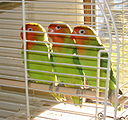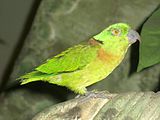Lovebird: Difference between revisions
→Aviculture: opinion, not encyclopedic fact, training birds has as much to do with the person as the bird. This info would be better suited for a page on bird training, not lovebird specific |
→Description: article originally written with British English. Changing to keep article consistent. Let's decide one version of English or the other, but not both in the same article |
||
| Line 29: | Line 29: | ||
==Description== |
==Description== |
||
Lovebirds vary in size from about 13 to 17 centimeters in length and from about 40 to 60 grams in weight. They are among the smallest parrots in the world, and they are characterized by a stocky build, a short blunt tail, and a relatively large beak for their overall size. Wild-type lovebirds are mostly green with a variety of colours on their upper body depending on the species. The Fischer's Lovebird, Black-cheeked Lovebird, and the Masked Lovebirds have a white ring around their eyes. The Abyssinian Lovebird, the Madagascar Lovebird, and the Red-faced Lovebird are [[Sexual dimorphism|sexually dimorphic]]. Many |
Lovebirds vary in size from about 13 to 17 centimeters in length and from about 40 to 60 grams in weight. They are among the smallest parrots in the world, and they are characterized by a stocky build, a short blunt tail, and a relatively large beak for their overall size. Wild-type lovebirds are mostly green with a variety of colours on their upper body depending on the species. The Fischer's Lovebird, Black-cheeked Lovebird, and the Masked Lovebirds have a white ring around their eyes. The Abyssinian Lovebird, the Madagascar Lovebird, and the Red-faced Lovebird are [[Sexual dimorphism|sexually dimorphic]]. Many colour mutations have been produced by selective breeding in the species that are popular in aviculture.<ref name = KLB/> |
||
==Taxonomy== |
==Taxonomy== |
||
Revision as of 22:39, 27 November 2008
This article needs additional citations for verification. (March 2008) |
| Lovebird | |
|---|---|

| |
| Peach-faced Lovebird eating from a tree | |
| Scientific classification | |
| Kingdom: | |
| Phylum: | |
| Class: | |
| Order: | |
| Family: | |
| Subfamily: | |
| Tribe: | |
| Genus: | Agapornis Selby, 1836
|
| Species | |
|
Nine - see text | |
Lovebird is the commonly used name for any of the nine species of the genus Agapornis (Greek: αγάπη agape 'love'; όρνις ornis 'bird'). They are a social and affectionate small parrot. Eight species are native to the African continent; the Grey-headed Lovebird is native to Madagascar.
The name Lovebird stems from these parrots' strong, monogamous pair bonding and the long periods of time in which paired birds will spend sat beside one another. This is reflected by the bird's name in other languages: in German, "die Unzertrennlichen", and in French "les inséparables", both meaning "the inseparables".
Lovebirds live in small flocks and eat mainly fruit, vegetables, some grasses and seed. Abyssinian Lovebirds also eat insects and figs, and the Black-collared Lovebirds have a special dietary requirement for native figs making them almost impossible to keep in captivity.
Some species of the genus are amongst the most popular parrots kept as pets, and several colour mutations have been selectively breed in aviculture. Their average lifespan is 10 to 15 years.[1]
Description
Lovebirds vary in size from about 13 to 17 centimeters in length and from about 40 to 60 grams in weight. They are among the smallest parrots in the world, and they are characterized by a stocky build, a short blunt tail, and a relatively large beak for their overall size. Wild-type lovebirds are mostly green with a variety of colours on their upper body depending on the species. The Fischer's Lovebird, Black-cheeked Lovebird, and the Masked Lovebirds have a white ring around their eyes. The Abyssinian Lovebird, the Madagascar Lovebird, and the Red-faced Lovebird are sexually dimorphic. Many colour mutations have been produced by selective breeding in the species that are popular in aviculture.[2]
Taxonomy

The lovebird genus comprises nine species of which five are monotypic and four are divided into subspecies.[2] Eight of them are native in the mainland of Africa and the Madagascar Lovebird is native to Madagascar. In the wild the different species are separated geographically.
Species and subspecies:[4]
- Peach-faced Lovebird, Agapornis roseicollis, (Vieillot, 1818) — or Rosy-faced Lovebird
- Agapornis roseicollis catumbella, B.P. Hall, 1952
- Agapornis roseicollis roseicollis, (Vieillot 1818)
- Masked Lovebird, Agapornis personatus, Reichenow, 1887 — or Yellow-collared Lovebird
- Fischer's Lovebird, Agapornis fischeri, Reichenow, 1887
- Lilian's Lovebird, Agapornis lilianae, Shelley, 1894 — or Nyasa Lovebird
- Black-cheeked Lovebird, Agapornis nigrigenis, W.L. Sclater, 1906
- Madagascar Lovebird, Agapornis canus, (Gmelin, 1788) — or Grey-headed Lovebird
- Agapornis canus ablectaneus, Bangs, 1918
- Agapornis canus canus, (Gmelin, 1788)
- Abyssinian Lovebird, Agapornis taranta, (Stanley, 1814) — or Black-winged Lovebird
- Red-faced Lovebird, Agapornis pullarius, (Linnaeus, 1758) — or Red-headed Lovebird
- Agapornis pullarius pullarius, (Linnaeus, 1758)
- Agapornis pullarius ugandae, Neumann, 1908
- Black-collared Lovebird, Agapornis swindernianus, (Kuhl, 1820) — or Swindern's Lovebird
- Agapornis swindernianus emini, Neumann, 1908
- Agapornis swindernianus swindernianus, (Kuhl, 1820)
- Agapornis swindernianus zenkeri, Reichenow, 1895
Species
| Species (wild-types) | |||
|---|---|---|---|
| Common and binomial names | Photograph | Description[2] | Range |
| Peach-faced Lovebird or Rosy-faced Lovebird (Agapornis roseicollis) |
 |
15 cm (6 in) long. Mostly green, orange face, blue lower back and rump, horn-coloured beak | Africa |
| Masked Lovebird or Yellow-collared Lovebird (Agapornis personata) |
 |
14 cm (5.5 in) long. Mostly green, black head, yellow upper chest continuous with yellow collar, red beak, white eyerings | Africa |
| Fischer's Lovebird (Agapornis fischeri) |
 |
14 cm (5.5 in) long. Mostly green, orange upper body and head, blue lower back and rump, red beak, white eyerings | Africa |
| Lilian's Lovebird or Nyasa Lovebird (Agapornis lilianae) |
 |
13 cm (5 in) long. Mostly green including green back and green rump, orange head, red beak, white eyerings | Africa |
| Black-cheeked Lovebird (Agapornis nigrigenis) |
 |
14 cm (5.5 in) long. Mostly green, brownish-black cheeks and throat, reddish-brown forehead and forecrown, orange upper chest, red beak, white eyerings | Africa |
| Grey-headed Lovebird or Madagascar Lovebird (Agapornis canus) |
 |
13 cm (5 in) long. Mostly green with darker green on back, pale grey beak. Sexual dimorphism: male has a grey upper body, neck and head. | Madagascar |
| Abyssinian Lovebird or Black-winged Lovebird (Agapornis taranta) |
 |
16.5 cm (6.5 in) long. Mostly green, red beak, some black wing feathers. Sexual dimorphism: only the male has red on forehead and crown, females plumage is all green | Africa |
| Red-headed Lovebird or Red-faced Lovebird (Agapornis pullarius) |
 |
15 cm (6 in) long. Mostly green with red on upper neck and face. Sexual dimorphism: the male has more extensive and a darker red on face and head, and the male has a darker red beak than the female | Africa |
| Black-collared Lovebird or Swindern's Lovebird (Agapornis swindernianus) |
 |
13.5 cm (5 in) long. Mostly green, brown collar which has a black upper margin at the back of the neck, dark grey/black beak | Africa |
Aviculture
Lovebirds have the potential to make great pets for those who have the patience and time required of any parrot species. Because of their inclination to bond, they can form great long-term relationships with people.
Provided with adequate flying space, a stimulating environment, and appropriate nutrition a lovebird can become cherished companion parrot. They love to snuggle and often preen their favorite people.
Like with any other pet, it is essential that the person makes sure the birds they are about to buy were bred in captivity, rather than caught from the wild. Besides conservational and ethical reasons, animals caught wild are more likely to get sick and to die. Lovebirds, especially when kept individually or brought up hand-fed, make very good pets. They can be very interactive with humans, and when comfortable, will willingly perch on a finger or shoulders. Lovebirds rarely talk, but there is a chance they may learn to mimic human sounds if taught to at a young age. Lovebirds have a fairly loud call.
Housing
Lovebirds require an appropriately sized cage or aviary. Recommended space per bird is 1m×1m×1m. They require lots of toys such as willow branches, swings and other things to chew on and play with. Lack of toys and social stimulation may lead to boredom behavioral problems. Lovebirds are extremely social birds, and will enjoy several hours of interaction a day. Without this interaction, daily exercise, a roomy cage, and many toys to play with, they may resort to feather-plucking or other behavioral problems. They need a human who will dedicate lots of time with them and take the place of companion lovebirds. They love to bathe and sun themselves daily.
Diet
Lovebirds require a variety of food, such as pellets, fruits (sweetcorn, apple, pomegranate, strawberries, etc.), and vegetables (broccoli, carrot, mustard seed, watercress, squash, etc.) and seed (a mix of 14 varieties is recommended, plus wild seeding grasses, sesame seed, etc.). As a regular food, pellets are recommended, as the seed mixes generally sold in pet stores contain too much fat and are not a significant source of nutrition. Concentrated pellets specially made for birds provide a well-balanced diet. Birds should especially be exposed to a wide variety of foodstuffs when young.

Potential problems
Lovebirds are very vocal birds, making loud, high-pitched noises. Some make noise all day, especially during the first morning hours. Untamed birds will call even more than tame birds.
Lovebirds are also very active, and love to chew things. When they are flying within a household, it is wise to watch them carefully and protect any furniture, electrical wiring or anything else that they could possibly chew on.Try to place fresh willow or oak branches in a favorite spot to satisfy this natural behavior.
Lovebirds of different species can mate and produce sterile hybrid offspring. It is recommended to only place birds of the same species together, or of the same sex, for the sake of the potentially faulted hybrid offspring.
Because of their dominant nature, Lovebirds should be supervised when socializing with other species/genus (whether it be cat, dog, small mammal or other bird species). Lovebirds can be aggressive to other birds, without taking into account their small size. Hand raised Lovebirds tend not to be scared and pose even more of a threat to themselves. Toe biting can occur when Lovebirds are socializing/housed with small birds (ie. Parrotlets, Budgies, and even docile Cockatiels). They should not be housed with other bird genus as they can be injured or pose a threat to the other bird.
References
- ^ Alderton, David (2003). The ultimate encyclopedia of caged and aviary birds. London, England: Hermes House. pp. p. 216–219. ISBN 184309164X.
{{cite book}}:|pages=has extra text (help) - ^ a b c Le Breton, Kenny. Lovebirds...getting started. USA: T.F.H. Publictions. p. pp. 84–98. ISBN 0866224114.
{{cite book}}:|page=has extra text (help) - ^ Eberhard, Jessica R. (1998): Evolution of nest-building behavior in Agapornis parrots. The Auk 115(2):455-464.
- ^ "Zoological Nomenclature Resource: Psittaciformes (Version 9.004)". www.zoonomen.net. 2008-07-05.

